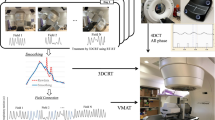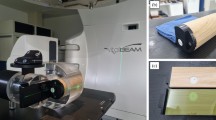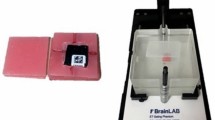Abstract
During radiation therapy for lung cancer, the respiratory motion of the target increases error and affects the treatment outcome. A four-dimensional computed tomography (4D-CT) technology developed recently can be used to obtain snapshot thoracic CT images during the entire respiratory cycle, which can be helpful in visualization of the tumor displacement in respiratory motion. This study employed a dynamic phantom to simulate tumor respiratory motion, with motion amplitudes of 2, 5 and 10 mm in the superior-inferior direction and motion periods of 4 and 6 s. 4D-CT imaging was applied to record the movement of the target, and maximum-intensity projection (MIP) imaging was used to define the internal target volume (ITV). Treatment plans were generated using three different treatment techniques—tomotherapy, intensity-modulated radiotherapy (IMRT) and volumetric modulated arc therapy (VMAT). In addition, using interchangeable insert modules (an ionization chamber for point dose measurement and Gafchromic EBT3 film for planar dose distribution) in the dynamic phantom, the dose received by the target was measured. The dose received with motion was compared with that received under stationary conditions for dose errors due to respiratory motion. The point dose differences between moving and stationary conditions for tomotherapy, IMRT and VMAT were 0.48 ± 0.51%, 0.17 ± 0.45%, and 0.68 ± 0.70%, respectively; and at motion amplitudes of 2, 5, and 10 mm, the mean dose differences were 0.27 ± 0.38%, 0.37 ± 0.55% and 0.68 ± 0.74%, respectively. Based on planar dose analysis, at motion amplitudes of 2 and 5 mm, the dose distribution differences between moving and stationary conditions using the three treatment methods were all very small, and all passed the gamma index test with a criterion of 3%/3 mm, while at an amplitude of 10 mm, the edge of the ITV was associated with significantly greater dose errors. As studies have shown that in only approximately 10% of pulmonary tumors move with an amplitude >10 mm, 4D-CT MIP imaging in combination with delineation of the ITV may resolve the issue of dose error in most cases. For tumors with large motion amplitudes due to respiration, respiratory gating method may be used to reduce healthy lung tissues inside treatment field.



Similar content being viewed by others
References
Liu, H. H., Balter, P., Tutt, T., Choi, B., Zhang, J., Wang, C., et al. (2007). Assessing respiration-induced tumor motion and internal target volume using four-dimensional computed tomography for radiotherapy of lung cancer. International Journal of Radiation Oncology Biology Physics, 68(2), 531–540.
Mechalakos, J., Yorke, E., Mageras, G. S., Hertanto, A., Jackson, A., Obcemea, C., et al. (2004). Dosimetric effect of respiratory motion in external beam radiotherapy of the lung. Radiotherapy and Oncology, 71(2), 191–200.
Mutaf, Y. D., Scicutella, C. J., Michalski, D., Fallon, K., Brandner, E. D., Bednarz, G., et al. (2011). A simulation study of irregular respiratory motion and its dosimetric impact on lung tumors. Physics in Medicine & Biology, 56(3), 845.
Schmidt, M. L., Hoffmann, L., Kandi, M., Møller, D. S., & Poulsen, P. R. (2013). Dosimetric impact of respiratory motion, interfraction baseline shifts, and anatomical changes in radiotherapy of non-small cell lung cancer. Acta Oncologica, 52(7), 1490–1496.
Hugo, G. D., Weiss, E., Badawi, A., & Orton, M. (2011). Localization accuracy of the clinical target volume during image-guided radiotherapy of lung cancer. International Journal of Radiation Oncology Biology Physics, 81(2), 560–567.
Josipovic, M., Persson, G. F., Logadottir, Á., Smulders, B., Westmann, G., & Bangsgaard, J. P. (2012). Translational and rotational intra-and inter-fractional errors in patient and target position during a short course of frameless stereotactic body radiotherapy. Acta Oncologica, 51(5), 610–617.
Bosmans, G., van Baardwijk, A., Dekker, A., Öllers, M., Boersma, L., Minken, A., et al. (2006). Intra-patient variability of tumor volume and tumor motion during conventionally fractionated radiotherapy for locally advanced non-small-cell lung cancer: a prospective clinical study. International Journal of Radiation Oncology Biology Physics, 66(3), 748–753.
Britton, K. R., Starkschall, G., Liu, H., Chang, J. Y., Bilton, S., Ezhil, M., et al. (2009). Consequences of anatomic changes and respiratory motion on radiation dose distributions in conformal radiotherapy for locally advanced non–small-cell lung cancer. International Journal of Radiation Oncology Biology Physics, 73(1), 94–102.
Erridge, S. C., Seppenwoolde, Y., Muller, S. H., van Herk, M., De Jaeger, K., Belderbos, J. S., et al. (2003). Portal imaging to assess set-up errors, tumor motion and tumor shrinkage during conformal radiotherapy of non-small cell lung cancer. Radiotherapy and Oncology, 66(1), 75–85.
Mah, D., Hanley, J., Rosenzweig, K. E., Yorke, E., Braban, L., Ling, C. C., et al. (2000). Technical aspects of the deep inspiration breath-hold technique in the treatment of thoracic cancer. International Journal of Radiation Oncology Biology Physics, 48(4), 1175–1185.
Ross, C. S., Hussey, D. H., Pennington, E. C., Stanford, W., & Doornbos, J. F. (1990). Analysis of movement of intrathoracic neoplasms using ultrafast computerized tomography. International Journal of Radiation Oncology Biology Physics, 18(3), 671–677.
Shimizu, S., Shirato, H., Ogura, S., Akita-Dosaka, H., Kitamura, K., Nishioka, T., et al. (2001). Detection of lung tumor movement in real-time tumor-tracking radiotherapy. International Journal of Radiation Oncology Biology Physics, 51(2), 304–310.
Underberg, R. W., Lagerwaard, F. J., Slotman, B. J., Cuijpers, J. P., & Senan, S. (2005). Use of maximum intensity projections (MIP) for target volume generation in 4DCT scans for lung cancer. International Journal of Radiation Oncology Biology Physics, 63(1), 253–260.
Zamora, D. A., Riegel, A. C., Sun, X., Balter, P., Starkschall, G., Mawlawi, O., et al. (2010). Thoracic target volume delineation using various maximum-intensity projection computed tomography image sets for radiotherapy treatment planning. Medical Physics, 37(11), 5811–5820.
Park, K., Huang, L., Gagne, H., & Papiez, L. (2009). Do maximum intensity projection images truly capture tumor motion? International Journal of Radiation Oncology Biology Physics, 73(2), 618–625.
Tian, Y., Wang, Z., Ge, H., Zhang, T., Cai, J., Kelsey, C., et al. (2012). Dosimetric comparison of treatment plans based on free breathing, maximum, and average intensity projection CTs for lung cancer SBRT. Medical Physics, 39(5), 2754–2760.
Rao, M., Wu, J., Cao, D., Wong, T., Mehta, V., Shepard, D., et al. (2012). Dosimetric impact of breathing motion in lung stereotactic body radiotherapy treatment using image-modulated radiotherapy and volumetric modulated arc therapy. International Journal of Radiation Oncology Biology Physics, 83(2), e251–e256.
Huang, L., Park, K., Boike, T., Lee, P., Papiez, L., Solberg, T., et al. (2010). A study on the dosimetric accuracy of treatment planning for stereotactic body radiation therapy of lung cancer using average and maximum intensity projection images. Radiotherapy and Oncology, 96(1), 48–54.
CIRS Dynamic Thorax Phantom Model 008A, Computerized Imaging Reference Systems, Inc, USA.
Rink, A., Vitkin, I. A., & Jaffray, D. A. (2005). Suitability of radiochromic medium for real-time optical measurements of ionizing radiation dose. Medical Physics, 32(4), 1140–1155.
Devic, S., Tomic, N., Aldelaijan, S., DeBlois, F., Seuntjens, J., Chan, M. F., et al. (2012). Linearization of dose–response curve of the radiochromic film dosimetry system. Medical Physics, 39(8), 4850–4857.
Lewis, D., Micke, A., Yu, X., & Chan, M. F. (2012). An efficient protocol for radiochromic film dosimetry combining calibration and measurement in a single scan. Medical Physics, 39(10), 6339–6350.
Borca, V. C., Pasquino, M., Russo, G., Grosso, P., Cante, D., Sciacero, P., et al. (2013). Dosimetric characterization and use of GAFCHROMIC EBT3 film for IMRT dose verification. Journal of applied clinical medical physics, 14(2), 4111.
Low, D. A., Harms, W. B., Mutic, S., & Purdy, J. A. (1998). A technique for the quantitative evaluation of dose distributions. Medical Physics, 25(5), 656–661.
International Commission on Radiation Units and Measurements. (1993). ICRU Report No 50: Prescribing, Recording and Reporting Photon Beam Therapy. Bethesda, MD: ICRU Publications.
International Commission on Radiation Units and Measurements. (1999). ICRU Report No 62: Prescribing, Recording and Reporting Photon Beam Therapy (Supplement to ICRU Report 50). Bethesda, MD: ICRU Publications.
Bortfeld, T., Jokivarsi, K., Goitein, M., Kung, J., & Jiang, S. B. (2002). Effects of intra-fraction motion on IMRT dose delivery: Statistical analysis and simulation. Physics in Medicine and Biology, 47, 2203e2220.
Jiang, S. B., Pope, C., Al Jarrah, K. M., Kung, J. H., Bortfeld, T., & Chen, G. T. (2003). An experimental investigation on intra-fractional organ motion effects in lung IMRT treatments. Physics in Medicine and Biology, 48, 1773e1784.
Chui, C. S., Yorke, E., & Hong, L. (2003). The effects of intra-fraction organ motion on the delivery of intensity-modulated field with a multileaf collimator. Medical Physics, 30, 1736e1746.
Schaefer, M., Münter, M. W., Thilmann, C., Sterzing, F., Haering, P., Combs, S. E., et al. (2004). Influence of intrafractional breathing movement in step-and-shoot IMRT. Physics in Medicine and Biology, 49, N175eN179.
Thiyagarajan, R., Sinha, S. N., Ravichandran, R., Samuvel, K., Yadav, G., Sigamani, A. K., et al. (2016). Respiratory gated radiotherapy-pretreatment patient specific quality assurance. Journal of medical physics, 41(1), 65–70.
Chen, H., Wu, A., Brandner, E. D., Heron, D. E., Huq, M. S., Yue, N. J., et al. (2009). Dosimetric evaluations of the interplay effect in respiratory-gated intensity-modulated radiation therapy. Medical Physics, 36(3), 893–903.
Riley, C., Yang, Y., Li, T., Zhang, Y., Heron, D. E., & Huq, M. S. (2014). Dosimetric evaluation of the interplay effect in respiratory-gated RapidArc radiation therapy. Medical Physics, 41(1), 011715.
Acknowledgement
This study was funded by Cathay General Hospital, Taiwan (Grant Number CGH-MR-B10413) and China Medical University, Taiwan (Grant Number CMU 105-S-12) and Tainan Municipal An-Nan Hospital, Taiwan (Grant Number DMRANHRF105-11).
Author information
Authors and Affiliations
Corresponding authors
Ethics declarations
Conflict of interest
All authors declare that they have no conflict of interest.
Rights and permissions
About this article
Cite this article
Yang, SN., Lin, CW., Chang, MB. et al. Dose Verification for Tumor Motion with Different Treatment Planning Systems: A Dynamic Thorax Phantom Study. J. Med. Biol. Eng. 38, 46–54 (2018). https://doi.org/10.1007/s40846-017-0367-5
Received:
Accepted:
Published:
Issue Date:
DOI: https://doi.org/10.1007/s40846-017-0367-5




